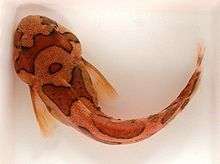Snailfish
The Liparidae, commonly known as snailfish or sea snails,[1] are a family of scorpaeniform marine fishes.
| Snailfish | |
|---|---|
 | |
| Snailfish (probably Elassodiscus tremebundus) caught in the eastern Bering Sea | |
| Scientific classification | |
| Kingdom: | Animalia |
| Phylum: | Chordata |
| Class: | Actinopterygii |
| Order: | Scorpaeniformes |
| Superfamily: | Cyclopteroidea |
| Family: | Liparidae T. N. Gill, 1861 |
| Type genus | |
| Liparis Scopoli, 1777 | |
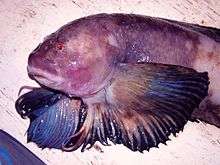
Widely distributed from the Arctic to Antarctic Oceans, including the oceans in between, the snailfish family contains more than 30 genera and about 410 described species,[2] but there are also many undescribed species.[3] They are closely related to the sculpins (family Cottidae) and lumpfish (family Cyclopteridae). In the past, snailfish were sometimes included within the latter family.
Description
The snailfish family is poorly studied and few specifics are known. Their elongated, tadpole-like bodies are similar in profile to the rattails. Their heads are large (compared to their size) with small eyes; their bodies are slender to deep, tapering to very small tails. The extensive dorsal and anal fins may merge or nearly merge with the tail fin. Snailfish are scaleless with a thin, loose gelatinous skin; some species, such as Acantholiparis opercularis have prickly spines, as well. Their teeth are small and simple with blunt cusps. The deep-sea species have prominent, well-developed sensory pores on the head, part of the animals' lateral line system.
The pectoral fins are large and provide the snailfish with its primary means of locomotion although they are fragile. They are benthic fish with pelvic fins modified to form an adhesive disc; this nearly circular disc is absent in Paraliparis and Nectoliparis species. Snailfish range in size from Paraliparis australis at 5 cm (2.0 in) to Polypera simushirae at some 77 cm (30 in) in length. The latter species may reach a weight of 11 kg (24 lb), but most species are smaller. Snailfish are of no interest to commercial fisheries.
Occurrence and habitat
The habitats chosen by snailfish are as widely variable as their size. They are found in oceans worldwide, ranging from shallow intertidal zones to depths of slightly more than 8,000 m (26,000 ft). This is a wider depth range than any other family of fish.[4] They are strictly found in cold waters, meaning that species of tropical and subtropical regions strictly are deepwater.[3][4][5] They are common in most cold marine waters and are highly resilient, with some species having antifreeze proteins.[6] It is the most species-rich family of fish in the Antarctic region, where generally found in relatively deep waters (shallower Antarctic waters are dominated by Antarctic icefish).[7]
The diminutive inquiline snailfish (Liparis inquilinus) of the northwestern Atlantic is known to live out its life inside the mantle cavity of the scallop Placopecten magellanicus. Liparis tunicatus lives amongst the kelp forests of the Bering Strait and the Gulf of St. Lawrence. The single species in genus Rhodichthys is endemic to the Norwegian Sea.[8] Other species are found on muddy or silty bottoms of continental slopes.
In October 2008, a UK-Japan team discovered a shoal of Pseudoliparis amblystomopsis snailfish at a depth of approximately 7,700 m (25,300 ft) in the Japan Trench.[9] These were, at the time, the deepest living fish ever recorded on film. The record was surpassed by a snailfish that was filmed at a depth of 8,145 m (26,722 ft) in December 2014 in the Mariana Trench,[10] and extended in May 2017 when another was filmed at a depth of 8,178 m (26,831 ft) in the Mariana Trench.[4][11] The species in these deepest records remain undescribed, but it has been referred to as the "ethereal snailfish". The deepest-living described species is Pseudoliparis swirei, also of the Mariana Trench, which has been recorded to 8,076 m (26,496 ft).[4][12] In general, snailfish (notably genera Notoliparis and Pseudoliparis) are the most common and dominant fish family in the hadal zone.[12] There are indications that the larvae of at least some hadal snailfish species spend time in open water at relatively shallow depths, less than 1,000 m (3,300 ft).[13]
Reproduction and life span
Reproductive strategies vary extensively among the species. As far as known, all species lay eggs that are relatively large in size (diameter up to 9.4 mm or 0.37 in).[4] The number of eggs varies extensively depending on species.[14] Some deposit their egg mass among cold-water corals, kelp or stones.[3][15] It is possible that the male guards the egg mass.[15] At least one species, Careproctus ovigerus of the North Pacific, is known to practice mouth brooding; that is, the male of the species carries the developing eggs around in his mouth. Some other species of the genus Careproctus are parasitic, laying their eggs in the gill cavities of king crabs.[3] After the eggs hatch, some species rapidly reach the adult size and only live for about one year,[15] but others have life spans of more than a decade.[16]
Diet
The diet of snailfish consists primarily of small benthic crustaceans, mollusks, polychaete worms, and other small invertebrates. Some species are also piscivorous. Specialist species such as Paraliparis rosaceus feed exclusively on sea cucumbers.
Genera
This family currently contains these genera:[2]
- Acantholiparis Gilbert & Burke, 1912
- Aetheliparis Stein, 2012[17]
- Allocareproctus Pitruk & Fedorov, 1993
- Careproctus Krøyer, 1862
- Crystallichthys Jordan & Gilbert, 1898
- Eknomoliparis Stein, Meléndez C. & Kong U., 1991
- Elassodiscus Gilbert & Burke, 1912
- Eutelichthys Tortonese, 1959
- Genioliparis Andriashev & Neyelov, 1976
- Gyrinichthys Gilbert, 1896
- Liparis Scopoli, 1777
- Lipariscus Gilbert, 1915
- Lopholiparis Orr, 2004
- Menziesichthys Nalbant & Mayer, 1971
- Nectoliparis Gilbert & Burke, 1912
- Notoliparis Andriashev, 1975
- Osteodiscus Stein, 1978
- Palmoliparis Balushkin, 1996
- Paraliparis Collett, 1879
- Polypera Burke, 1912
- Praematoliparis Andriashev, 2003
- Prognatholiparis Orr & Busby, 2001
- Psednos Barnard, 1927
- Pseudoliparis Andriashev, 1955
- Pseudonotoliparis Pitruk, 1991
- Rhinoliparis Gilbert, 1896
- Rhodichthys Collett, 1879
- Squaloliparis Pitruk & Fedorov, 1993
- Temnocora Burke, 1930
- Volodichthys Balushkin, 2012[18]

.jpg) Careproctus ovigerus (juvenile)
Careproctus ovigerus (juvenile)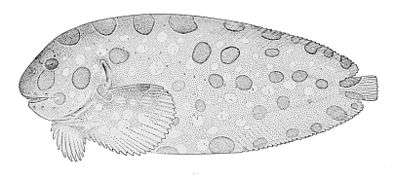 Crystallichthys cyclospilus
Crystallichthys cyclospilus Elassodiscus tremebundus
Elassodiscus tremebundus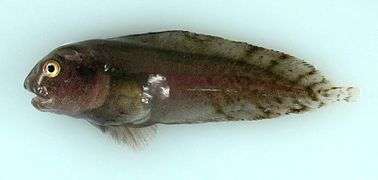

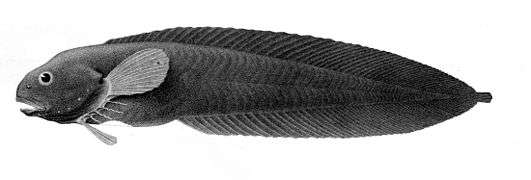 Paraliparis bathybius
Paraliparis bathybius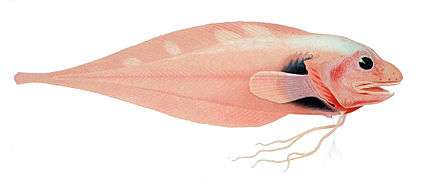 Rhodichthys regina
Rhodichthys regina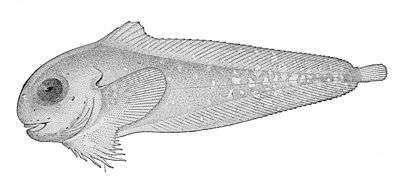
References
- "The Sea Snails. Family Liparidae". Gulf of Maine Research Institute. Retrieved March 6, 2012.
- Froese, Rainer, and Daniel Pauly, eds. (2015). "Liparidae" in FishBase. February 2015 version.
- Gardner, J.R.; J.W. Orr; D.E. Stevenson; I. Spies; D.A. Somerton (2016). "Reproductive Parasitism between Distant Phyla: Molecular Identification of Snailfish (Liparidae) Egg Masses in the Gill Cavities of King Crabs (Lithodidae)". Copeia. 104 (3): 645–657. doi:10.1643/CI-15-374.
- Gerringer, M.E.; T.D. Linley; P.H. Yancey; A.J. Jamieson; E. Goetze; J.C. Drazen (2016). "Pseudoliparis swirei sp. nov.: A newly-discovered hadal snailfish (Scorpaeniformes: Liparidae) from the Mariana Trench". Zootaxa. 4358 (1): 161–177. doi:10.11646/zootaxa.4358.1.7. PMID 29245485.
- Sakurai, H.; G. Shinohara (2008). "Careproctus rotundifrons, a New Snailfish (Scorpaeniformes: Liparidae) from Japan". Bull. Natl. Mus. Nat. Sci. Ser. A (Suppl. 2): 39–45.
- Evans, R.E.; G.L. Fletcher (2001). "Isolation and characterization of type I antifreeze proteins from Atlantic snailfish (Liparis atlanticus) and dusky snailfish (Liparis gibbus)". Biochimica et Biophysica Acta (BBA) - Protein Structure and Molecular Enzymology. 1547 (Suppl. 2): 235–244. doi:10.1016/S0167-4838(01)00190-X. PMID 11410279.
- Eastman, J.T.; M.J. Lannoo (1998). "Morphology of the Brain and Sense Organs in the Snailfish Paraliparis devriesi: Neural Convergence and Sensory Compensation on the Antarctic Shelf". Journal of Morphology. 237 (3): 213–236. doi:10.1002/(sici)1097-4687(199809)237:3<213::aid-jmor2>3.0.co;2-#. PMID 9734067.
- Hogan, C.M. (2011): Norwegian Sea. Encyclopedia of Earth. Eds. Saundry, P. & Cleveland, C.J. National Council for Science and the Environment. Washington DC
- Morelle, R. (2008). "'Deepest ever' living fish filmed". BBC News.
- Morelle, Rebecca (2014-12-19). "New record for deepest fish". BBC News. Retrieved 2017-08-26.
- "Ghostly fish in Mariana Trench in the Pacific is deepest ever recorded". CBC News. 2017-08-25. Retrieved 2017-08-26.
- Linley, T.D.; M.E. Gerringer; P.H. Yancey; J.C. Drazen; C.L. Weinstock; A.J. Jamieson (2016). "Fishes of the hadal zone including new species, in situ observations and depth records of Liparidae". Deep Sea Research Part I: Oceanographic Research Papers. 114: 99–110. Bibcode:2016DSRI..114...99L. doi:10.1016/j.dsr.2016.05.003.
- Gerringer, M.E.; A.H. Andrews; G.R. Huus; K. Nagashima; B.N. Popp; T.D. Linley; N.D. Gallo; M.R. Clark; A.J. Jamieson; J.C. Drazen (2017). "Life history of abyssal and hadal fishes from otolith growth zones and oxygen isotopic compositions". Deep Sea Research Part I: Oceanographic Research Papers. 132: 37–50. Bibcode:2018DSRI..132...37G. doi:10.1016/j.dsr.2017.12.002.
- Stein, D.L. (1980). "Aspects of Reproduction of Liparid Fishes from the Continental Slope and Abyssal Plain off Oregon, with Notes on Growth". Copeia. 1980 (4): 687–699. doi:10.2307/1444445. JSTOR 1444445.
- Kawasaki, I.; J. Hashimoto; H. Honda; A. Otake (1983). "Selection of Life Histories and its Adaptive Significance in a Snailfish Liparis tanakai from Sendai Bay". Bulletin of the Japanese Society of Scientific Fisheries. 49 (3): 367–377. doi:10.2331/suisan.49.367.
- Orlov, A.M.; A.M. Tokranov (2011). "Some Rare and Insufficiently Studied Snailfish (Liparidae, Scorpaeniformes, Pisces) in the Pacific Waters off the Northern Kuril Islands and Southeastern Kamchatka, Russia". ISRN Zoology. 201: 341640. doi:10.5402/2011/341640.
- Stein D.L. (2012). "A Review of the Snailfishes (Liparidae, Scorpaeniformes) of New Zealand, Including Descriptions of a New Genus and Sixteen New Species". Zootaxa. 3588: 1–54. doi:10.11646/zootaxa.3588.1.1.
- Balushkin A.V. (2012). "Volodichthys gen. nov. New Species of the Primitive Snailfish (Liparidae: Scorpaeniformes) of the Southern Hemisphere. Description of New Species V. solovjevae sp. nov. (Cooperation Sea, the Antarctic)". Journal of Ichthyology. 52 (1): 1–10. doi:10.1134/s0032945212010018.
External links

